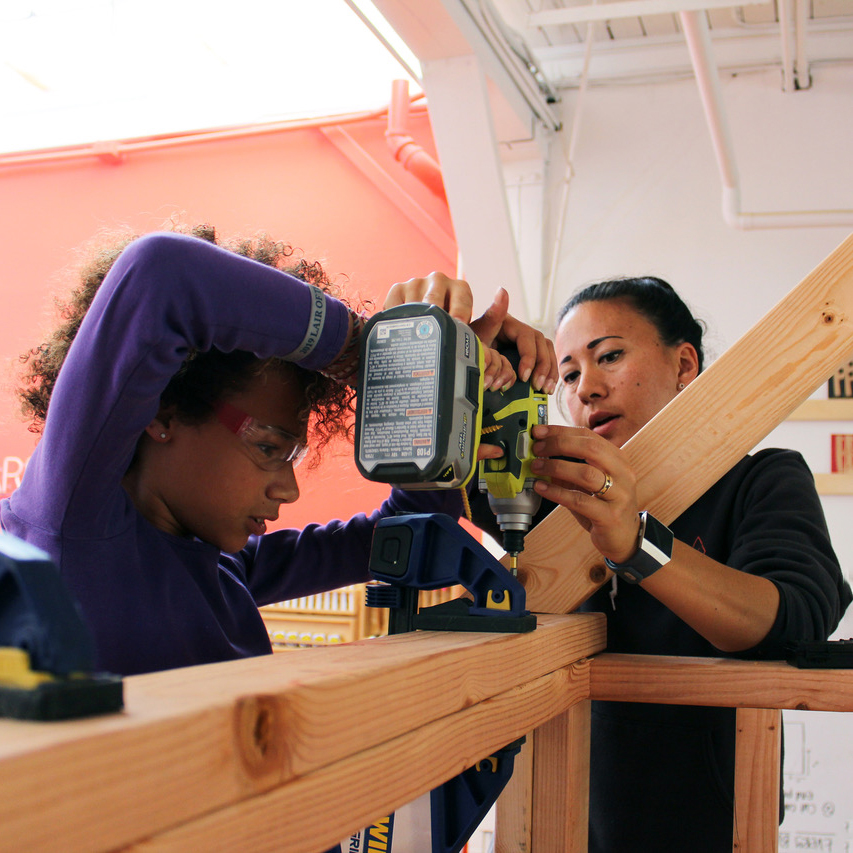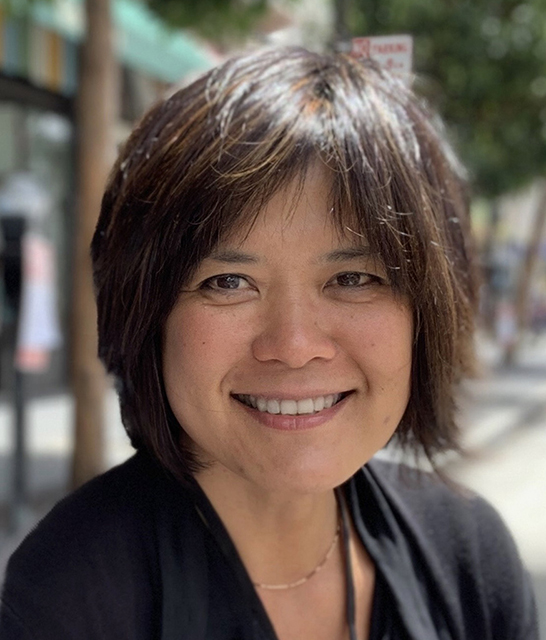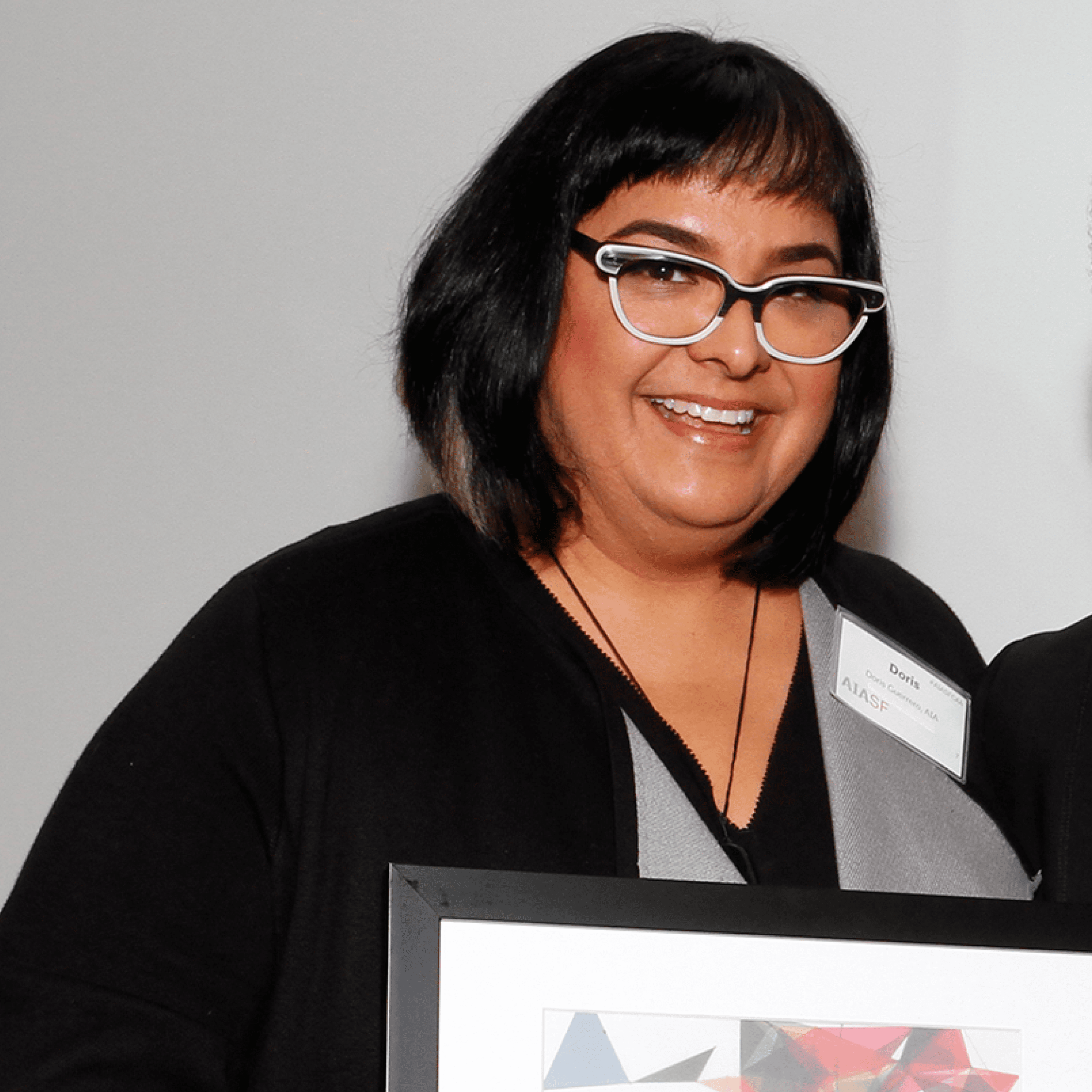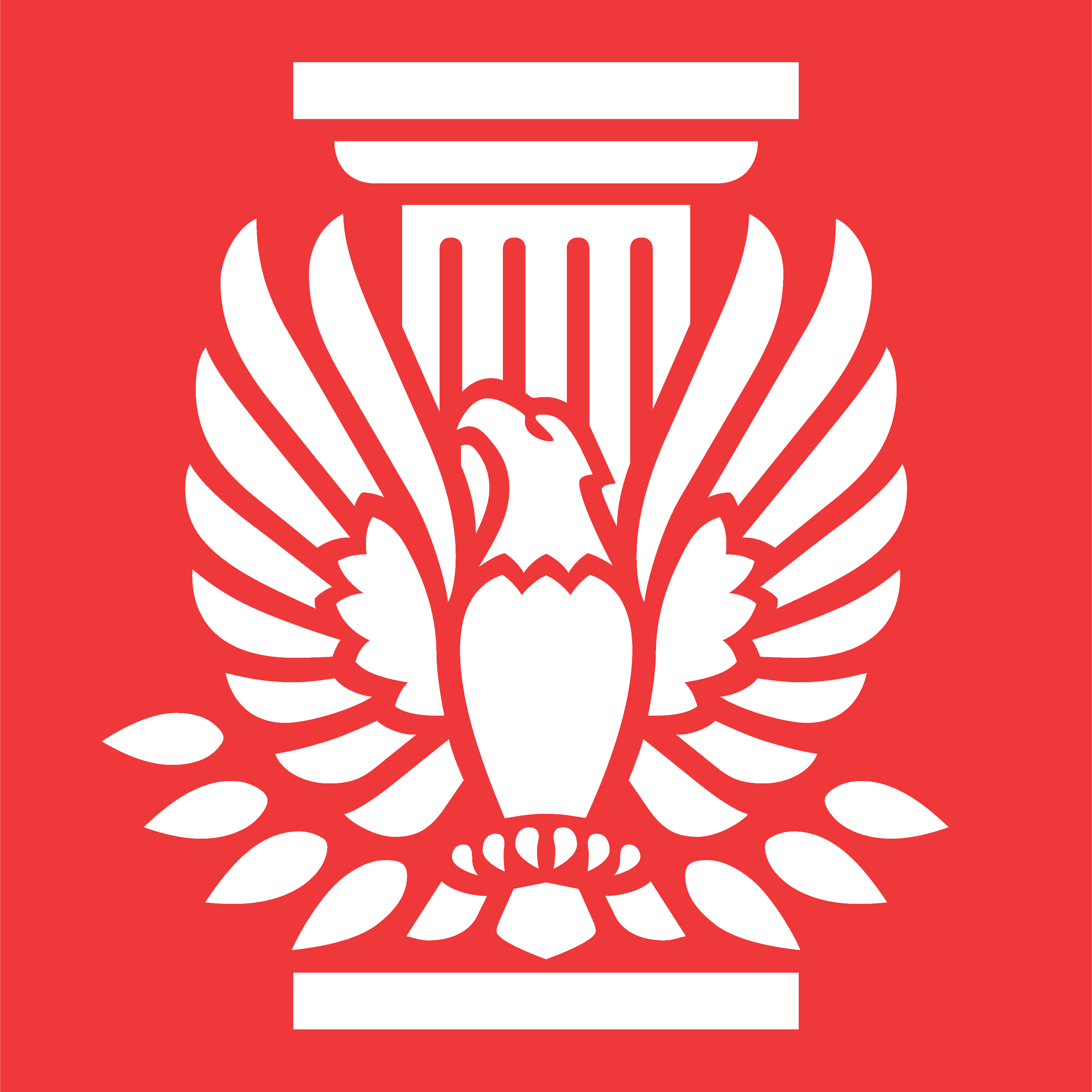The Community Builders Series continues to celebrate Community Alliance Awards honorees and the positive impact they are continuing to make in the community.
Congratulations to the 2022 Community Alliance Awards recipients — view awardees HERE.

Emily Pilloton
Girls Garage is the culmination of decades of thinking, refining, working and connecting to community and working with young people. My own personal love of architecture and the built world came at a young age. My grandfathers were both engineers, and my grandmothers were both librarians. You could argue that architecture is at the intersection of those two things. At a young age, I made the connection between making things with my hands and making meaning in the world.
When I was in high school I had the opportunity to travel to Belize with a group of teens from around the country and spent the summer there. We worked alongside local masons and builders and built an entire town park. At 16 years old, I got to pick up a machete, mix concrete by hand, and use a power saw. I got to see something come to life that was 3-dimensional, occupied by people, and used in a beautiful, celebratory way.
Fast forward to 2008 after graduate school: I had been working in the field of architecture and design while making furniture on the side. At this time in my life, I felt very disconnected from the things that made me fall in love with architecture as a teenager at the park site in Belize. So I decided to quit my job and started my own non-profit, which has evolved into Girls Garage today.
The organization was founded in 2008 as Project H Design, and thought the work has grown and evolved, the soul is still there. I wanted to use design and building with young people to change the authorship four built world, and to challenge the way people think about who gets to build the world. I wanted to provide young people with the power (and power tools!) to build the world for themselves.
Through my work with young people, architecture is a way of creating space for everyone, bringing people together, and a way of having agency in the world or changing the world in a real way.
I have never identified as a leader prior to this pandemic. We immediately moved our spring programs in an online format at the beginning of the pandemic. Our whole reason for existence is to serve young people and canceling our classes and program just wasn’t an option for us. Instead, I went into action and put together 200 builder kits, starter tool kits, etc. in order for the kids and teens to build at home. We provided kits to girls who weren’t in our programs. We even partnered with a fabrication shop down the street from the organization to create 1,500 face shields.
Today we are at a milestone in the evolution of our programming during the pandemic and we are thinking about how do we continue to make these programs and classes deeply meaningful to the girls. This summer with the generous support of our funders we put together giant toolboxes and gave them to the teen girls. This was a seminal moment for the girls not only built a chair or shelf for our programs but kept building outside the classes. There are some things we never would have tried if it wasn’t for this pandemic and they have an impact that I never would have imagined.
I really tried to root our programming in that and how do we use this moment to rethink what we already do in a way that will create the impact that we haven’t even thought about.
Last summer we built a summer parklet around the corner from Girls Garage. This year we built a 5000sq foot chicken coop and our meaning the girls' ambitions continue to grow. And it’s our job as the leaders for the organization to fulfill them. My pipe dream project would be to renovate and flip a house with a crew of all teenage girls and sell it and put the projected revenue in their college fund. I think we are working our way up to full-scale projects. I love the idea of being able to work in the way an architecture or general contractor firm would and I think that’s where we are headed. In particular for the advanced teen girls.
Organizationally at this moment, we are trying to make Girls Garage a place of safety, solidarity, and of voice. This is a place where girls walk in the door and leave feeling louder, stronger, and taller. And we are learning how to do this in so many ways with different classes, programs, and not shying away from political work. We are growing into a social justice identity.
Emily Pilloton is the Founder and Executive Director of the nonprofit Girls Garage. A designer, builder, educator, and author, she has taught thousands of young girls how to use power tools, weld, and build projects for their communities. She has presented her work and ideas on the TED stage, The Colbert Report, and in the documentary film If You Build It. She is currently a lecturer in the College of Environmental Design at the University of California, Berkeley, and lives in the San Francisco Bay Area. (Year: 2022; Category: Mentor)

Fay Darmawi
The Urban Film Festival (SFUFF) started as a passion project about seven years ago from my frustration with the affordable housing development industry. Over the years, the affordable housing crisis has increased with more obstacles and challenges. The industry is not filling the gap because it is not connecting to the community it is serving. As a result, the housing issue isn't getting solved.
During my career, I taught myself screenwriting and developed relationships with a group of filmmakers. I saw that the environmental movement was using film to create a groundswell movement. I believe the affordable housing community can do the same. What we need to do is change the story of those who live in affordable housing. Many of the narratives are moral judgments around poor people. These stories are myths and stereotypes. We are attacking the housing question on the tactical programmatic level, and it's not working. We need to actually be attacking the issue at the narrative level, to tell stories of community empowerment.
SFUFF pivoted from a 100 percent volunteer-led organization in March of this year when I was hired as the Executive Director. It has been a very busy, rewarding, and challenging year. We had to transition from live events to online and hybrid in-person events and ramped up our technological capacity to deliver programs using virtual festival platforms and film projection mapping. In addition, SFUFF took on an exciting 2-year residency program with Yerba Buena Center for the Arts (YBCA). SFUFF's residency at YBCA is a vehicle to explore a film program that centers on storytelling and community voices. YBCA is our treasured local arts institution and they share our commitment to civic engagement through arts and culture.
SFUFF's first major residency program, City is Alive took place on October 17 in the historic Bayview-Hunter's Point neighborhood as a powerful collaboration with Bayview-based partner organizations Imprint City and Young Community Developers. City Is Alive was a one-day digital and in-person celebration of the neighborhood's everyday heroes who have fought for resources and have brought joy to the Bayview.
City Is Alive also presented Imprint City's annual event BayviewLIVE, the only festival in SF dedicated to urban arts and culture, in tandem with Bayview murals come to life by the community through the creative power of Crux, an XR movement founded by and centering Black technologists.
The City is Alive event is an extension of a storytelling project we have been working on with the Young Community Developers over the last year. The project focuses on the legacy of everyday heroes.
SFUFF's program goal is to connect the past, present, and future through storytelling. We strive to create aesthetic art experiences that connect us, amplify our power, and reflect our collective voice. We are trying to elicit the visions, needs, and community strategies that already exist and elevate them so that the community vision becomes the city vision.
Structural change in urban city planning is what SFUFF is addressing by bringing together community organizations, cultural institutions, and the public sector to collaborate on shaping the built environment.
The big question for SFUFF is how to transform the urban planning profession to become an integral part of the community using the power of storytelling which is an important tool in movement-building.
I am an urban planner, and I never felt like I fit in or believed in the methods. I think that community storytelling is a way for the profession to create more opportunities to be inclusive and generate more equitable outcomes.
The built environment in the fields of architecture and urban planning has a huge longitudinal impact. We build things that last for hundreds of years, and when you build inequity for hundreds of years, that's two generations of inequity. How can architecture and urban planning become more responsive to communities who have been disempowered and disinvested? In addition to making sure we don't recreate those inequities and bake them into concrete, literally. Change is a slow process but we have to in order to meet the urgent needs of our communities.
Fay Darmawi is a film festival producer, community development banker, and urban planner interested in using all forms of storytelling and media. She is the Founder and Executive Director of the SF Urban Film Fest, a film festival focused on civic engagement inspired by great storytelling. Her 25 years of experience as a leader in affordable housing finance, including managing the low-income housing tax credit platform for Silicon Valley Bank, as well as five years of screenwriting training, informs her media-related work.
(Year: 2019; Category: Alliance Award)

Doris Anna Guerrero
Doris Anne Guerrero, Interiors Lead, EHDD, Senior Adjunct Professor, CCA Architecture Program, Principal of dForm
Doris Anne Guerrero is an interior architect with a wildly diverse portfolio of professional design experience. She has been a professor and mentor for young designers and students in the Bay Area for over 10 ten years.
(Year: 2016; Mentor Award)
I have reflected on where I was when I was awarded the 2016 Community Alliance Mentor Award at the time and where I am today.
2016 was a really important time because that is when I shifted from working with licensing professionals in architecture and teaching professional practice classes. I evolved from a professor teaching advance studios to supporting students in becoming practitioners. I transitioned to an Internship Coordinator where I helped students and alumni navigate the vision for their practice. Since 2016, this has been the focus. Watching my students grow into leadership positions. Started teaching in 2016 and really saw my student growing into leaders. This is what I love to do and it is very grassroots.
The economic crisis in 2018 was the golden era, there was this fresh perspective on the diversity of the architecture practice and what architects can do in their community. We were reaping the benefits of the financial and economic downturn to looking at practice very differently.
You don’t have to be a person designing and creating buildings to be an architect.
I always tell my students that I am here to give them a voice as an individual and help them build an agency. The place of inflection with a junior-level designer is developing their voice – going from a passive state to becoming a thinking individual, and acknowledging your contribution to the community and practice.
In my career, I have worked in traditional cornshell, multifamily, urban design, landscape, high-rise, nonprofit, etc. I am always speculative, curious and interested in becoming an expert in different practice areas. I moved my career focus into the Interior Design Division at CCA about 3-4 years ago. I thought I can really do some work here. I am always looking to see how can I evolve. At the same time in my career, I started focusing on interior architecture.
Supporting the growth of new designers has been important to me in the workplace. I have had opportunities to work with teams of young designers across the country and internationally giving them the agency and voice in the process. I work as a leader to support their voice and a collaborator to promote their growth.
I just recently started at an organization that aligns with my personal values. The organization understands social justice, environmental justice, and sustainability and it’s at the top of the list. It came to me at the right time and I am so excited. I feel like I am in the right place to make a real impact on sustainability and to keep doing work to support young designers in the workplace and the studio. I think the next Version 3.0 is going to be more grassroot efforts. Sometimes I wonder if I am making a difference with 1 or 2, 5, or 40 students or designers. However, when I see their work 5 years down the road and how they have developed into leaders and mentors it is so rewarding.
COVID-19 has cause more one-on-one conversations on work and collaborations one-on-one and forced us to look at the granular of our lives and focus on individual relationships. It has been a revelation for me. My hope for the future is create dialogue between people who don’t agree. My question to myself is to look at things differently and also through social justice lens. As a person of color, I also know that I have made mistakes and glossed over or the uniqueness of people. I would love the conversation to not be about polar opposites or contingents but for this to be an opportunity for people share their experiences, to respect each other for their context and to show some courage around mistakes that have made. The responsibility relies on all of us individually.
This is the crusts of the skillset that I want to hone, learn, and teach others. Looking into the future, am I going to teach, yes? Putting on my social justice lens. My trojan horse is going to be looking at design from the lens of equity and teaching these skills to young designers. Going forward and to approach that work with an even more granular, thoughtful, mindful approach.
Doris Anne Guerrero is the principal of dForm, a San Francisco design firm with interests in architecture, professional practice, landscape architecture, urban design, digital fabrication, emergent form, and research-based processes. In addition to 17 years of professional practice, she has been a guest lecturer, critic, and educator for more than 10 years. Inspired by communities near and far, Guerrero has been a lead designer and architect on local, national, and global projects, including numerous technology workplaces, urban multi-unit housing, and the design/restoration of civic and rural open space.

Prescott Reavis
Prescott Reavis, Founder and Director of Anomili Design + Planning
(Year: 2017; Categories: Mentor / Social Impact)
Prescott Reavis has been working on projects with youths and the black communities in the SF Bay Area shaping communities of change-makers and giving them tools to have a voice in the neighborhoods and communities they live in. Reavis shared what he has been working on recently and his long-term passion project.
Since the Community Alliance Award Program in 2017, I left AND Architecture+Community Planning (formerly Asian Neighborhood Design) in 2018 to start my own firm and work with Black and Brown communities with the focus on community planning and engagement and projects that help uplift communities and co-create with the community. What is most important about the work is supporting and learning about challenges in the community and where planning, architecture, and design can fill a role.
Most of my work has been focused on Oakland with the Black Cultural Zone in Oakland. The Black Cultural Zone started as a collaborative and now it's a CDC and a community hub serving as a multipurpose service to provide business models and educational opportunities for black-owned businesses, black homeowners, black residents, and anything around the black communities in Oakland. We are doing studies at different sites. One site we acquired for activation of an outdoor hub (East Oakland mall) as a COVID-19 response to provide hot food, food boxes, and COVID-19 kits (i.e. mask, hygiene, information). The second phase for this site is to create opportunities for a black farmers market and a small gathering area for African dance, non-profits who have outdoor classrooms, healing gardens, and more.
My long term passion project is to start a design-build program for young people in East Oakland and base it on several different programs such as Girls Garage and Public Workshop and their Tiny WAP program in Philadelphia. These two programs encourage young people to be activists and also help them with skill-building and job training. My goal is to develop and create opportunities for skill-based cohorts that can build projects in Oakland.
What this also goes back to what is happening in the world with police violence. This provides an opportunity to understand who actually has the right to be in public spaces. If you are building out in public space and start to understand the zoning and historical nature of a neighborhood, you start to understand who created the regulations in the neighborhood, and more importantly how to shape those regulations. Part of what I do is the empowerment of how you can take control of your own block, your neighborhood, your city, your county, and your state. It's really about ownership and understanding who has ownership and the right to public space. A lot of people think you don't have the right to public space because it is policed but, it's the opposite. It is publicly owned and therefore it should have public oversite and safety. Safety to me is the activation of spaces from the people that live there who curate the way space is operated or used. That's what we don't see a lot because people are fearful of a lot of rules and regulations on what they can do on their sidewalk. If we can break those down and teach young people how to have public oversite, then adults will question, if these young people are doing these things why can't we figure this out? Or hire them to do this for us. It's a way to provide opportunities to jobs and it allows people to see young people as contributors to making positive changes in their community. Whereas some people see them as those who cause problems but, you have to learn how to be a trouble-maker. Your mind is inquisitive to solve problems and not to create them.
This project needs to be hyperfocused because each city has different needs, different populations, rooted in the cultural impact. How you leverage their impact is significant. It's something that I would like to focus on in East Oakland, where I feel the needs are the greatest.
The other side of my work is around youth engagement and mentorship. It has been a whirlwind change. Engaging young people on how to create equitable and just communities, that they are citizens, and should be a part of placemaking, city-making, and community-making because they are living in these places. Young people are actually in public spaces the most. Therefore their voices need to be heard if you want to have them engaged, they need to part of the process. I have had four different teaching artist engagements with non-profit social justice organizations to place a lens on how youth can become change agents.
In one of these teaching opportunities, I worked with Design Justice + Designing Space on a project to run the first restorative justice youth design workshop in Detriot. High school students from six non-profits in the area were tasked to create a restorative justice plan to reallocate 53 million dollars for a failed jail site. We worked over six weeks with the teens on a framework with a series on background information the students had to learn including, what is restorative justice, social justice, Planning 101, and Architecture 101. Then they went back to their non-profits to do some inhouse brainstorming on what their spaces would look like. Then in a one day workshop, they ideated what their project would be; creating the pieces with vision boards, a final report, and a video presentation of how they saw themselves as space activators.
I had another opportunity to work with the Yerba Buena Institute for the Arts and Martin Luther King Elementary School. I worked with 120 sixth graders in the Fall and 90 eighth graders in the Spring. I helped them develop spaces for support on campus; places for students to be students, the opportunity to have fresh and healthy food including how to grow, sell, cook, and be entrepreneurs to develop their crafts and hobbies. They worked in groups on pavilion or kiosk models with vision boards and sketched to scale to solve an issue with their design of the pavilion or kiosk. In addition, they had to integrate solar panels, and lighting into the pavilion that functioned.
All the groups were great and one of the student groups in Detriot came up with one of the most powerful ideas —a mental health spa. It came from the idea of people coming from trauma, financial difficulties to loss, and served as a place to go to heal. That is something that adults have not contemplated on. That's the power of working with young people they don't have the constraint of ideas or the understanding of limitations so their ideas are limitless and have such depth and simplicity.
Since leaving AND it's spawned work and projects with a number of organizations in the Oakland including the East Oakland Collaborative, and these opportunities have given me the space to work with communities that have the most impact and are the most meaningful to me.
